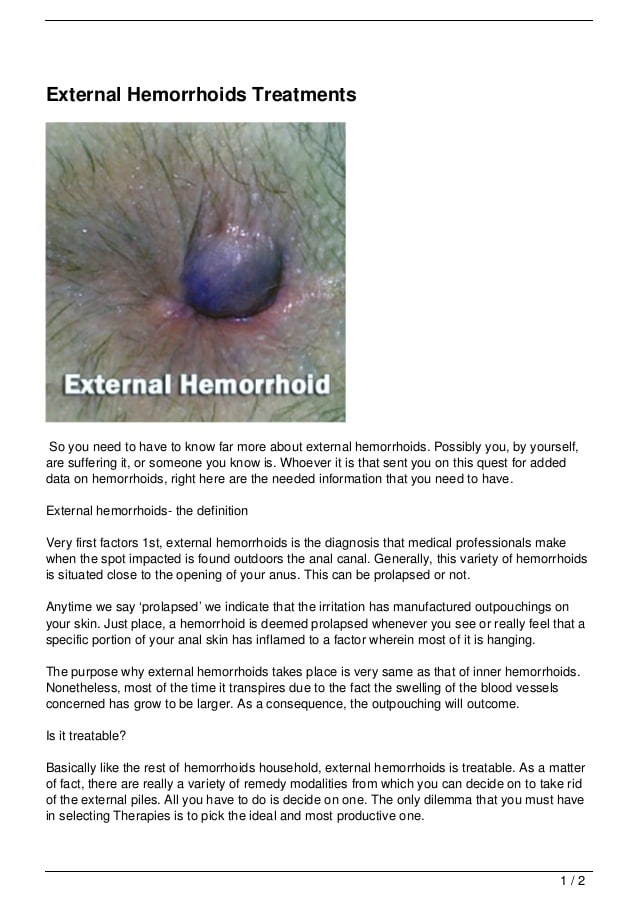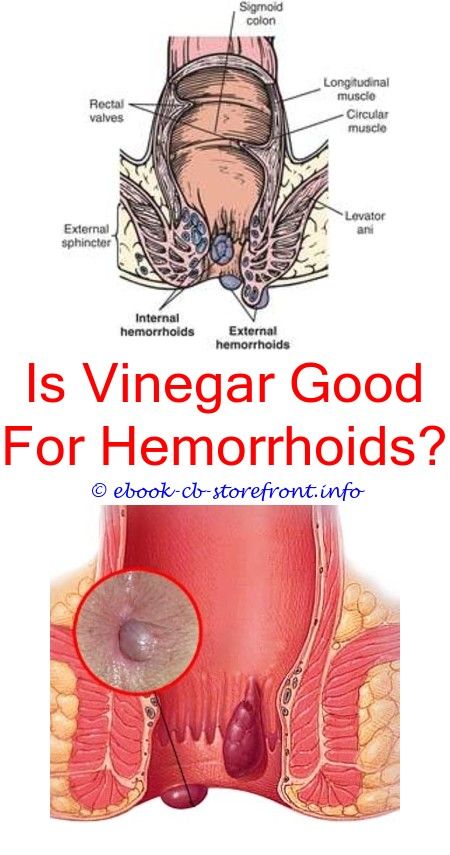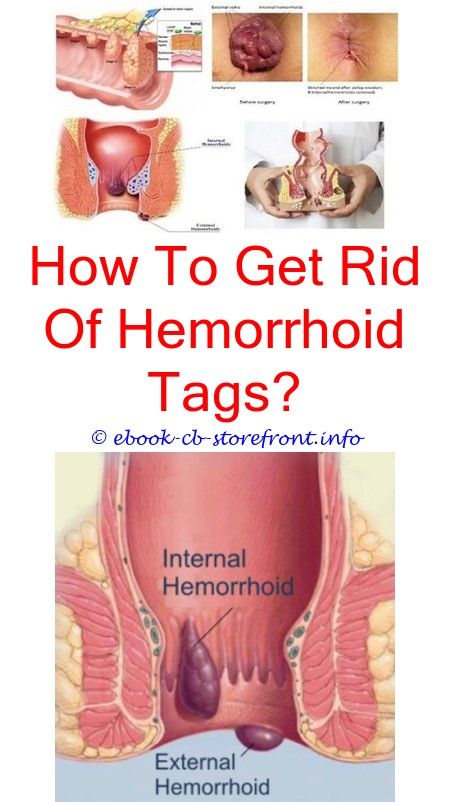What Are The Treatments For Hemorrhoids
If at-home treatments for hemorrhoids don’t help you, you may need a medical procedure. There are several different procedures that your provider can do in the office. These procedures use different techniques to cause scar tissue to form in the hemorrhoids. This cuts off the blood supply, which usually shrinks the hemorrhoids. In severe cases, you may need surgery.
Other Possible Causes Of Rectal Bleeding
Other causes that could be behind your rectal bleeding include:
- Anal cancer
- Colon cancer
While many people automatically worry about colon or rectal cancer, its much more likely to be a ruptured hemorrhoid, an anal fissure, or another similar condition. Colon cancer is still the third most commonly diagnosed cancer in the United States, though. In 2019, the American Cancer Society predicts there will be:
- 101,420 new cases of colon cancer and
- 44,180 new cases of rectal cancer
For this reason, it is imperative you see a doctor to rule out colorectal cancer if you experience rectal bleeding.
What Can I Do To Ease Hemorrhoid Pain
There are many ways to ease the pain of hemorrhoids.
At-home methods include over-the-counter pain medications, creams or wipes, sitz baths, and many lifestyle changes to prevent the worsening of your hemorrhoids.
If at-home treatments are not working, talk to your doctor about non-invasive treatments.
Rubber band ligation is a non-invasive procedure that involves placing one or two rubber bands on the internal hemorrhoids to cut off the circulation.
Injection or sclerotherapy involves the injection of a chemical solution to shrink the hemorrhoid tissue.
Coagulation is also an option. Lasers, infrared light, or heat can be used to harden and shrivel your hemorrhoids.
If all else fails, you can talk to your doctor about the surgical procedures to alleviate hemorrhoids.
Be careful when trying laser hemorrhoid surgery, as it can be very painful.
Read Also: How To Treat Hemorrhoids After Delivery
Don’t Miss: What To Do When Hemorrhoids Pop
How Are They Diagnosed
Your doctor may perform one or more tests to examine the anal or rectal area for hemorrhoids:
- Looking at the anus or rectum. A doctor will likely be able to diagnose an external or prolapsed internal hemorrhoid through a visual examination.
- Doing a digital rectal exam. The doctor will insert a finger covered with a lubricated glove into the anus or rectum to feel for signs of hemorrhoids with the fingers.
- Using an imaging scope. This will help them look at the inside of your rectum to examine for internal hemorrhoids. Theyll usually insert a thin tube with the light on the end into your rectum. Tools used for this diagnosis may include an anoscope or sigmoidoscope.
Hemorrhoids have the same or similar symptoms to some other conditions. For that reason, see a healthcare professional if your symptoms continue for longer than a week.
Some conditions also cause rectal bleeding like hemorrhoids sometimes do. These include:
But blood from your digestive tract often appears black in your stool unless the bleeding occurs near your rectum and anus. If youre seeing bright red blood on the toilet paper after you wipe, its most likely due to a hemorrhoid or anal fissure.
Anal fissures and anorectal abscesses are the most likely cause of sharp pain while you have a bowel movement, but you might mistake them for a hemorrhoid.
Here are some home remedies to try if your symptoms arent too severe:
What Causes Rectal Bleeding

Rectal bleeding can occur for several reasons and the most common reasons are hemorrhoids and anal fissures.
Hemorrhoids
Rectal bleeding in hemorrhoids occurs when you pass really hard stool and it scrapes the surface of a hemorrhoid in the rectum . This sort of bleeding is painless because the rectum doesnt have any pain sensory receptors. Bleeding from hemorrhoids in the anus , on the other hand, is painful because the anus has pain sensory receptors.
Bleeding also occurs when a thrombosed hemorrhoid bursts due to pent up pressure. A thrombosed hemorrhoid occurs when a blood clot is formed inside a hemorrhoid. The hemorrhoid fills up with blood to a point that it has to burst to release pressure. The bleeding should only last a few seconds or minutes and itll stop. A thrombosed hemorrhoid can be an internal or external hemorrhoid so if an internal thrombosed hemorrhoid bleeds, it results in rectal bleeding.
Anal Fissures
Anal fissures are tears, splits, or cuts on the sensitive mucosal lining of the anal canal. Its very painful especially when moving your bowels and afterward. An anal fissure is an injury so it results in bleeding. You will notice the bright red blood in the toilet that is separate from your stool or on the tissue paper when you wipe.
Rectal bleeding can also occur because of the following less common reasons:
- Anal, rectal, or colon cancer
- Crohns disease
Also Check: Is Peroxide Good For Hemorrhoids
You May Like: How Can You Tell If You Have Internal Hemorrhoids
Symptoms Of The Thrombosed Hemorrhoid
The primary and easily identifiable symptom is the pain in your anus skin. When you walk, stand, or sit, there will be intense pain in and around your anus area.
Common symptoms are,
What Medications And Other Products Treat Hemorrhoids
Medications are used to control symptoms by softening the stool, decreasing the inflammation of the hemorrhoids, and treating the pain. Stool softeners work by increasing the water and fat content within the stool allowing it to be passed more easily. Docusate sodium is the most often recommended drug in this class .
Inflammation can be controlled with over-the-counter creams or suppositories. Some brand ingredients include low dose topical anesthetics to help with symptoms. Others contain astringents that help shrink the swollen tissues. Both may contain low dose steroids to decrease inflammation. People with diabetes should check with their pharmacist or health care professional before using OTC hemorrhoid treatments. If the medication contains a vasoconstrictor it may elevate blood sugar levels if absorbed in large amounts. Prescription-strength lidocaine or hydrocortisone may be offered by the health care professional.
Grade 2 and 3 hemorrhoids are initially treated the same way, using techniques to destroy hemorrhoids. These include injecting the hemorrhoid vein to make it sclerose or harden, using rubber bands to choke off the blood supply and make the hemorrhoidal tissue shrivel, or other procedures that cause the mucosa to shrivel and die.
Read Also: What Helps Hemorrhoids Go Away
What If Ive Already Popped It
If youve already popped a hemorrhoid, its important to take steps to reduce your risk of infection. See your doctor as soon as possible so you can be properly evaluated and treated. They can make sure there are no complications. A sitz bath, which involves soaking the area in a few inches of warm water, may help with discomfort temporarily. Read how to do this.
After soaking for about 20 minutes, gently pat the area dry with a clean towel, making sure you dont scrub.
Youll also want to look out for signs of a possible infection and report them to your doctor. Signs of possible infection include:
- heat or redness
- fever
- fatigue
However, its best to see a doctor as soon as possible to avoid more complications and to ensure you receive a proper diagnosis and treatment.
If youve got a hemorrhoid thats causing pain or discomfort, resist the urge to pop it. There are plenty of other things you can do at home for relief without added risk.
Start by gently cleaning the area and reducing inflammation:
Next, try to soften your stools to keep your digestive system in good working order to reduce your risk of further irritating or damaging a bleeding hemorrhoid. Here are some tips:
Questions To Ask Your Doctor
- Why do I have hemorrhoids?
- Are there any lifestyle changes I can do that can relieve or prevent hemorrhoids?
- I saw blood on toilet paper. Is this serious?
- Are having hemorrhoids a sign of another health condition?
- Will I always have hemorrhoids?
- Is there medicine I can take for hemorrhoids? Are there side effects?
Read Also: Is Aloe Vera Good For Hemorrhoids
Recommended Reading: How To Get Rid Of Hemorrhoids Over The Counter
How To Treat External Hemorrhoids
Hemorrhoids are caused due to an inflammation of the hemorrhoidal veins in the rectum. This inflammation occurs as a result of excessive pressure in the area. Depending on the how badly the veins are affected, the hemorrhoids can be external or internal. External hemorrhoids are located under the skin of the anus.
However common this this condition, it does make it less annoying, uncomfortable or painful. That is why it is important to know how to reduce this inflammation. In this oneHOWTO article we will tell you how to treat external hemorrhoids in order to decrease pain and discomfort.
Why Are Internal Prolapsed Hemorrhoids At A Greater Risk Of Becoming Thrombosed
Whether internal or external, if your hemorrhoid is prolapsed it is at a greater risk of becoming thrombosed. When outside the anus the hemorrhoids blood supply can be cut off or limited by the anal sphincter limiting blood flow.
Since thrombosis occurs as a result of a lack of blood flow, these types of hemorrhoids are particularly susceptible to this painful condition.
Read Also: How To Get Rid Of Hemorrhoids Fast After Birth
Read Also: Do Bidets Help With Hemorrhoids
How To Get Rid Of Hemorrhoids: Diagnosis And Treatments
Most individuals who have hemorrhoids discover them by either
- feeling the lump of an external hemorrhoid when they wipe themselves after a bowel movement,
- noting drops of blood in the toilet bowl or on the toilet paper, or
- feeling a prolapsing hemorrhoid after bowel movements.
With a history of symptoms, a physician can begin diagnosis on the basis of a careful examination of the anus and anal area. Although the physician should try his or her best to identify the hemorrhoids, it is perhaps more important to exclude other causes of hemorrhoid-like symptoms that require different treatment such as
- anal fissures,
What Are The Signs And Symptoms Of An Internal Or Prolapsed Hemorrhoid

Most often, internal hemorrhoids have no symptoms but are only found if there is bleeding with a bowel movement or if the hemorrhoid prolapses so that it can be felt outside of the anus. This may lead to itching and pain as well as the bleeding.
Prolapse of an internal hemorrhoid occurs when the internal hemorrhoids swell and extend from their location in the rectum through the anus. A prolapsed internal hemorrhoid:
- Can be felt as a lump outside the anus
- Can be gently pushed back through the anus, this may resolve the location of the hemorrhoid, but does not fix the hemorrhoid itself
- May enlarge and swell even more if it cannot be pushed back
- May become entrapped, which requires more urgent medical attention
Hemorrhoids may also cause anal itching , and a constant feeling of needing to have a bowel movement .
Internal hemorrhoid severity can be graded:
- Grade I: Prominent blood vessels with no prolapse
- Grade II: Prolapse with bearing down but with spontaneous reduction
- Grade III: Prolapse with bearing down but requiring manual reduction
- Grade IV: Prolapse with inability to manual reduction
Don’t Miss: How To Help Poop With Hemorrhoids
Are Hemorrhoids Different During Pregnancy
No one likes to talk about them, but hemorrhoids are a fact of life for many people, especially during pregnancy. Hemorrhoids are simply veins inside or outside of your anus that have become large and swollen.
Also called piles, they can look like varicose veins when outside your body. Hemorrhoids develop frequently during pregnancy, especially in the third trimester and during and shortly after childbirth.
You may have hemorrhoids only during pregnancy, or you may have them at other times of your life as well.
The causes of your hemorrhoids may be unique to pregnancy. You can often treat or prevent hemorrhoids with home-based remedies and lifestyle adjustments.
There are two types of hemorrhoids:
- internal hemorrhoids, which are inside of your body
- external hemorrhoids, which are outside of your body
Your symptoms may vary depending on which type you have.
hemorrhoid symptoms during pregnancy
- burning
- swelling
Generally, you will experience these symptoms with external hemorrhoids. You may have no symptoms with internal hemorrhoids.
You may also develop a blood clot in an external hemorrhoid. This is known as a thrombosed hemorrhoid. They are generally hard, inflamed, and more painful.
Its possible to push out an internal hemorrhoid when having a bowel movement. If this occurs, you may experience bleeding and discomfort.
Up to 50 percent of women develop hemorrhoids during pregnancy.
Recommended Reading: How To Treat Hemorrhoids After Giving Birth
Can Hemorrhoids Be Prevented
You can help prevent hemorrhoids by:
- Eating foods that are high in fiber
- Taking a stool softener or a fiber supplement
- Drinking enough fluids every day
- Not straining during bowel movements
- Not sitting on the toilet for long periods of time
NIH: National Institute of Diabetes and Digestive and Kidney Diseases
Also Check: What Gets Rid Of Hemorrhoids Fast
Are External Hemorrhoids Dangerous
External hemorrhoids are rarely dangerous. They can develop a blood clot that may burst, but although this will cause several minutes of bleeding , it will usually end independently. If it does not, a person should seek emergency medical treatment.
Anyone who experiences regular rectal bleeding should avoid assuming that it is from a hemorrhoid. Rectal bleeding can signify other issues, including colorectal cancer or anal cancer. A person should discuss regular rectal bleeding and any other symptoms with a doctor.
How Do Doctors Get Rid Of External Hemorrhoids
If you have exhausted all the efforts mentioned above, your doctor may recommend you get a minimally invasive procedure to treat your hemorrhoids.
Outpatient treatments are generally performed in a doctorâs office.
The most common non-surgical doctor treatment for external hemorrhoids is called a rubber band ligation.
Your doctor will tie a tight band around the base of your hemorrhoid. This will cut off the blood supply and cause the surrounding tissue to scar as it heals.
In most cases, it takes two to four procedures separated by six to eight weeks to eliminate the hemorrhoid completely.
Coagulation is another method of treatment used by doctors . This involves the used of infrared light, heat, or cold to shrink the hemorrhoid.
Sclerotherapy is another non-surgical procedure to treat external hemorrhoids. In sclerotherapy, your doctor will inject a chemical that will shrink the hemorrhoid.
For severe external hemorrhoids that do not respond to outpatient treatment, your doctor may suggest a hemorrhoidectomy. This is a surgical procedure that cures most cases of protruding or persistent external hemorrhoids. During the surgery, a small incision will be made around the hemorrhoid tissue. The swollen and inflamed blood vessels, that are causing the hemorrhoid, will be removed.
Another option is laser hemorrhoid surgery.
Hemorrhoid supplements can also help provide external hemorrhoid relief. Check out these hemorrhoid supplement reviews to see which ones can help you.
Recommended Reading: How Do You Treat Internal Hemorrhoids
Severe Hemorrhoids Vs Mild Hemorrhoids: Stages
Many physicians use a grading system to categorize hemorrhoids along four stages:
- First-degree hemorrhoids: Hemorrhoids that bleed, but do not prolapse. These are slightly enlarged hemorrhoids, but they do not protrude outside the anus.
- Second-degree hemorrhoids: Hemorrhoids that prolapse and retract on their own . These may come out of the anus during certain activities like passing stool, and then return back inside the body.
- Third-degree hemorrhoids: Hemorrhoids that prolapse and must be pushed back in by a finger.
- Fourth-degree hemorrhoids: Hemorrhoids that prolapse and cannot be pushed back in the anal canal. Fourth-degree hemorrhoids also include hemorrhoids that are thrombosed or that pull much of the lining of the rectum through the anus.
Anal Itching At Night
Itching at night can interfere with a good night’s sleep. Scratching during sleep can pose a problem when you aren’t aware you are doing it. To minimize damage from unintentional scratching, keep your nails trimmed and consider wearing a pair of light, soft, cotton gloves. For some, antihistamines may help. Ask your healthcare provider if this is an option for you.
Also Check: What Are The Side Effects Of Hemorrhoids
What Is The Difference Between Internal And External Hemorrhoids
Internal hemorrhoids and external hemorrhoids are different for many reasons. These reasons include, severity, symptoms, and treatment. Internal hemorrhoids donât have many symptoms because of their location. They are far enough inside of the rectum that they canât be felt or seen. The only sign of these may be hemorrhoid bleeding.
External hemorrhoids are under the skin around the anus. Because of their location, external hemorrhoids tend to come with a great deal of symptoms. They are in an area that has more pain-sensing nerves present. That is why hemorrhoid pain is more intense with external hemorrhoids. Check out this blog post for information on how to relieve hemorrhoid pain.
Can Hemorrhoids Pop What To Do If That Happens

Can hemorrhoids pop? When a thrombosed hemorrhoid becomes too full of blood, it can burst. This can lead to a short period of bleeding. Keep in mind that a thrombosed hemorrhoid is usually very painful before it actually bursts. Once it bursts, you will likely feel an immediate sense of relief due to the release of extra pressure from the accumulated blood.
If you have some bleeding but also continue to have pain or discomfort, you probably only have a bleeding hemorrhoid, rather than a ruptured hemorrhoid.
You May Like: Do Hemorrhoids Go Away On Their Own